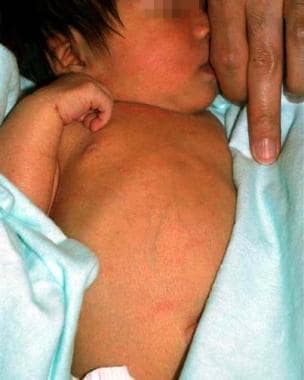Background
Erythema toxicum neonatorum (ETN) is a benign self-limited eruption occurring primarily in healthy newborns in the early neonatal period. Erythema toxicum neonatorum is characterized by macular erythema, papules, vesicles, and pustules, and it resolves without permanent sequelae. [1] See the image below.
 A 5-day-old newborn with erythematous papules with surrounding indistinct blotchy erythema visible on the abdomen. Image courtesy of Jining I. Wang, MD.
A 5-day-old newborn with erythematous papules with surrounding indistinct blotchy erythema visible on the abdomen. Image courtesy of Jining I. Wang, MD.
Also see the article, Pediatric Erythema Toxicum.
Pathophysiology
Increased levels of immunological and inflammatory mediators (eg, interleukins 1 and 8, eotaxin, the adhesion molecule E-selectin, the water-channel proteins aquaphorin 1 and aquaphorin 3, the chemotactic factor psoriasin, high-mobility group box chromosomal protein 1, nitric oxide and its isoforms, the antimicrobial peptide LL-37) suggest that erythema toxicum neonatorum may be an immune system reaction. [2, 3, 4] The location of erythema toxicum neonatorum to primarily hair-bearing areas suggests that the hair follicle may be involved. Additionally, the number of mast cells is increased around hair follicles in involved skin. [5]
The eosinophilic infiltrate of erythema toxicum neonatorum suggests an allergic- or hypersensitivity-related etiology, but no allergens have been identified. Newborn skin appears to respond to any injury with an eosinophilic infiltrate. Because erythema toxicum neonatorum is rarely seen in premature infants, it is believed that immunologically mature newborn skin is required to produce this reaction pattern. [6]
Contactants and mechanical irritation have been considered and rejected as etiologies.
Etiology
The cause of erythema toxicum neonatorum is unknown. Multiple theories have been proposed to explain this common disorder.
Neonates have an increased number of hair follicles compared with adults, and the occurrence of erythema toxicum neonatorum in non–hair-bearing areas such as palms and soles is rare. Inflammatory cells tend to concentrate around hair follicles, and coccilike microbes have been demonstrated in the follicular epithelium and inside the inflammatory cells. This suggests that erythema toxicum neonatorum may be a response to microbes that have penetrated the hair follicle. This process may possibly be integral in developing the new immune system. [7]
The high frequency of eosinophilia suggests an allergic basis, leading some authors to suggest that erythema toxicum neonatorum may be an immediate hypersensitivity reaction to a substance passed from the mother transplacentally; however, convincing support is lacking for this theory. [8]
No responsible exotoxin, allergen, component of sebum, or infectious agent has been linked credibly to erythema toxicum neonatorum.
Medications administered to newborns and the mode of feeding have no effect on incidence.
Other proposed theories include a transient adjustment reaction of the skin to mechanical or thermal stimulation or an acute graft-versus-host reaction induced by the maternal-fetal transfer of lymphocytes before or during delivery. [9] Analysis of skin samples of 2 male patients with erythema toxicum neonatorum did not support a graft-versus-host reaction because no maternal cells were found in the samples using fluorescence in situ hybridization identification of cells with 2 XX chromosomes. [10]
Risk factors include higher birth weight, greater gestational age, and vaginal delivery. A positive correlation has been recognized between the length of labor and both the incidence of erythema toxicum neonatorum and the duration of the cutaneous manifestations. [11, 12]
Epidemiology
Frequency
United States
A review of incidence in the United States across a range of ethnic groups revealed an incidence of 7%. [13] Studies involving US populations have reported an incidence of up to 30%. [14]
International
International studies have found a similar range in the incidence of erythema toxicum neonatorum, occurring in approximately one third to one half of full-term infants. A Brazilian study reported a prevalence rate of 21.3%. [15]
Race
No racial or ethnic predisposition is known.
Sex
The prevalence is higher in males (55%) than in females (30%), [11, 15] except among females born of first pregnancies, who have a higher rate than males of first pregnancies.
Age
Erythema toxicum neonatorum presents within the first 4 days of life in full-term infants, with the peak onset occurring within the first 48 hours following birth. Rare cases have been reported at birth. [16, 17]
Incidence rises with increasing gestational age and birth weight. [6]
Delayed onset rarely may occur in full-term and preterm infants up to age 14 days. [18, 19]
Prognosis
Prognosis of erythema toxicum neonatorum is excellent. Erythema toxicum neonatorum is a transient eruption with spontaneous resolution and no associated long-term morbidity. Erythema toxicum neonatorum may recur in approximately 11% of patients up to age 6 weeks. Recurrences tend to be mild and resolve without sequelae. Although one study found that infants with erythema toxicum neonatorum had an increased risk of atopy, [20] subsequent studies have failed to support this finding.
Patient Education
Reassure parents that erythema toxicum neonatorum is not inherited or infectious, has no complications, and has an excellent prognosis with spontaneous resolution.
-
A 5-day-old newborn with erythematous papules with surrounding indistinct blotchy erythema visible on the abdomen. Image courtesy of Jining I. Wang, MD.
-
Yellow pustules, some with evidence of rupture, in a full-term infant at 6 hours of life.
-
Erythematous blotchy patches localized to the trunk in a neonate.
-
A Wright-Giemsa stain performed on the contents of a ruptured pustule reveal numerous eosinophils.




